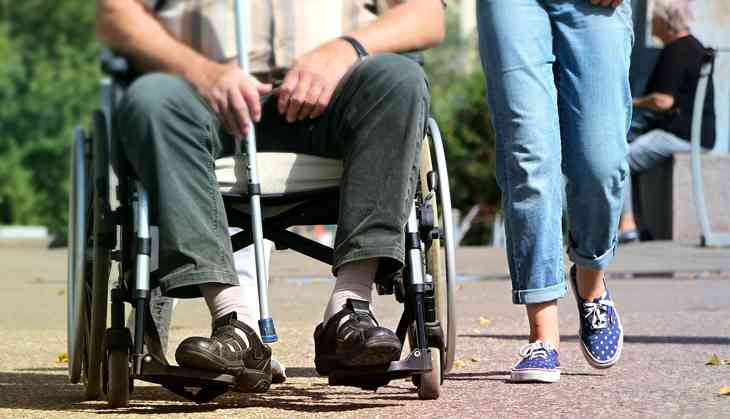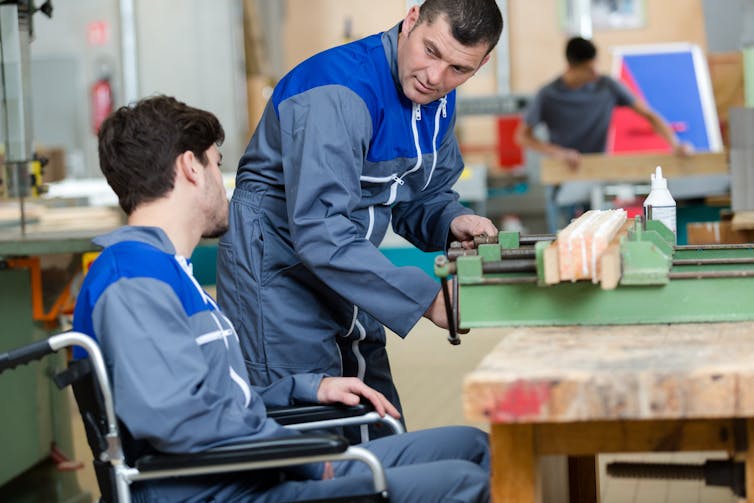People with disability have a lot to offer employers

Nathan is a young man who enjoys his life and is doing well by anybody’s standards. He studied drama, ancient history and English at school. He is a motivational speaker and has a part-time job at a radio station. He is buying his own home.
Nathan also has Down syndrome. While his life may seem relatively “ordinary” when compared to most people, it seems extraordinary when compared to those with Down syndrome. This is because people with disabilities in Australia don’t get the right opportunities to develop their skills. And it shouldn’t be this way.
Australia has some of the poorest labour market outcomes for people with disability in the OECD. A 2010 report found employment rates of people with health problems or disability were at 40%, and falling. Almost one in two (45%) lived in poverty, compared to an OECD average of 22%.
Australia needs policies that capitalise on the strengths of people with disability rather than simply helping them “overcome” limitations.
A lifetime of disadvantage
The cards are stacked against people with disability from the get go. People with any disabilities – not just those with intellectual disability – are less likely to finish high school.
Roughly 15% of children with disability are educated in segregated “special” schools and 19% in a special classroom in a mainstream school. This happens despite evidence showing that on the whole, children with disability are more likely to prosper in mainstream settings.

We know being included is critical for the health and well-being of all children. But children and teenagers with a disability are more likely to be bullied at school, less likely to participate in team sports and have fewer intimate friendships.
Poorer educational outcomes such as these have lifelong ramifications. They reduce the possibility of making a successful transition out of school to further education and training, or employment. This lack of participation in the economy constrains the potential to form meaningful relationships and leads to poverty, housing stress and homelessness. The scene is set for a lifetime of disadvantage.
Being disadvantaged is, of course, bad for your health. Disadvantage increases your risk of pretty much everything including most cancers, diabetes, heart disease, and mental health.
Read more: Social determinants – how class and wealth affect our health
Disadvantaged economically
Research shows economic inactivity and under-employment are detrimental to people’s mental health. While factors such as being wealthy, and having affordable housing and social support help reduce the negative mental health effects of disability.
People with disability are more likely to be unemployed or economically inactive. And even if they are employed, they are more likely to be underemployed and have poor quality jobs including lower perceived fairness of pay.
While many disabilities, such as Nathan’s, begin at birth, most are acquired later in life through accidents or injury. Some chronic conditions, such as multiple sclerosis, also tend to present later in life.
When adults acquire a disability, they may already have completed education and training and be employed. But even then, the diagnosis can shift someone into socioeconomic disadvantage. People might lose their job, reduce their work hours or move into a lower skilled job.
Some reductions in economic participation may be due to limitations related to people’s impairments. But it’s clear many people with disability experience discrimination in getting and maintaining meaningful employment and career progression.

Capitalising on abilities
Most policy documents and strategies to improve the lives of people with disability, such as the National Disability Strategy, focus on “adaptions” to enable mainstream participation such as ramps, captioning on visual materials, and hearing loops on public transport. These are important, but radical, transformational change is also needed.
We need to see opportunities that disability brings. For instance, companies such as Microsoft are deliberately recruiting people with autism who have enhanced abilities to see patterns and pick up mistakes faster and more accurately than their peers.
Read more: Why employing autistic people makes good business sense
Human rights lawyer Elise Roy, who has been deaf since the age of ten, says losing her hearing “was one of the greatest gifts I’ve ever received”. It enabled her to create design solutions others literally couldn’t see. It also made her a great soccer goalie as her highly developed visual senses meant she could “see” and read the pitch in ways hearing goalies could not.
![]() We need to see possibilities, not only barriers. We need to think creatively about how the skills, expertise and abilities of people with disability can be capitalised on. This won’t eliminate the problems people with disability face but it will help take them out of the cycle of disadvantage.
We need to see possibilities, not only barriers. We need to think creatively about how the skills, expertise and abilities of people with disability can be capitalised on. This won’t eliminate the problems people with disability face but it will help take them out of the cycle of disadvantage.
Anne Kavanagh, Professor and Head, Gender and Women’s Health Unit, Centre for Health Equity, University of Melbourne
This article was originally published on The Conversation. Read the original article.
First published: 1 December 2017, 19:09 IST
